Analysis of Team, Situational, and Transformational Leadership Models
VerifiedAdded on 2023/06/11
|9
|2329
|245
Essay
AI Summary
This essay provides a detailed analysis of three prominent leadership theories: team leadership, situational leadership, and transformational leadership. It begins by exploring team leadership, highlighting its advantages in fostering collaboration and managing complex situations, while also acknowledging potential drawbacks such as conflicts and blame games. The essay then transitions to transformational leadership, emphasizing its focus on inspiring and motivating employees to exceed expectations and achieve organizational goals, while also addressing criticisms regarding its reliance on individual leaders. Finally, it examines situational leadership theory, discussing its adaptive approach to leadership based on follower maturity levels and its benefits in promoting employee participation and development, alongside potential challenges like worker confusion. Each theory is illustrated with real-world examples, such as Paycor's use of team leadership, Apple Inc.'s adoption of transformational leadership, and healthcare organizations' implementation of situational leadership, demonstrating their practical applications in contemporary organizations. The essay concludes by underscoring the significance of these leadership models in providing managers with valuable tools for effective business management. Desklib offers a wealth of similar resources for students.
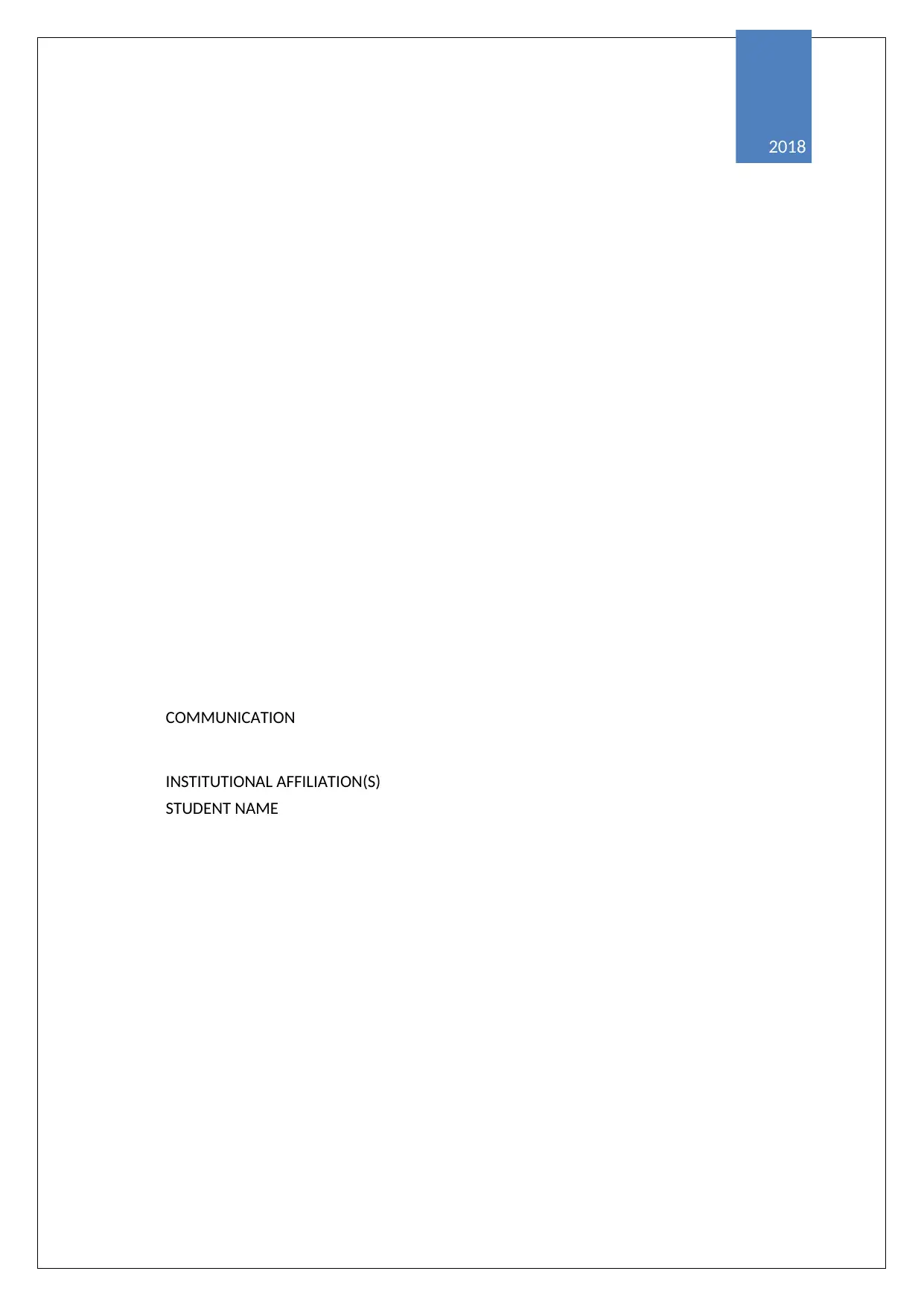
2018
COMMUNICATION
INSTITUTIONAL AFFILIATION(S)
STUDENT NAME
COMMUNICATION
INSTITUTIONAL AFFILIATION(S)
STUDENT NAME
Paraphrase This Document
Need a fresh take? Get an instant paraphrase of this document with our AI Paraphraser
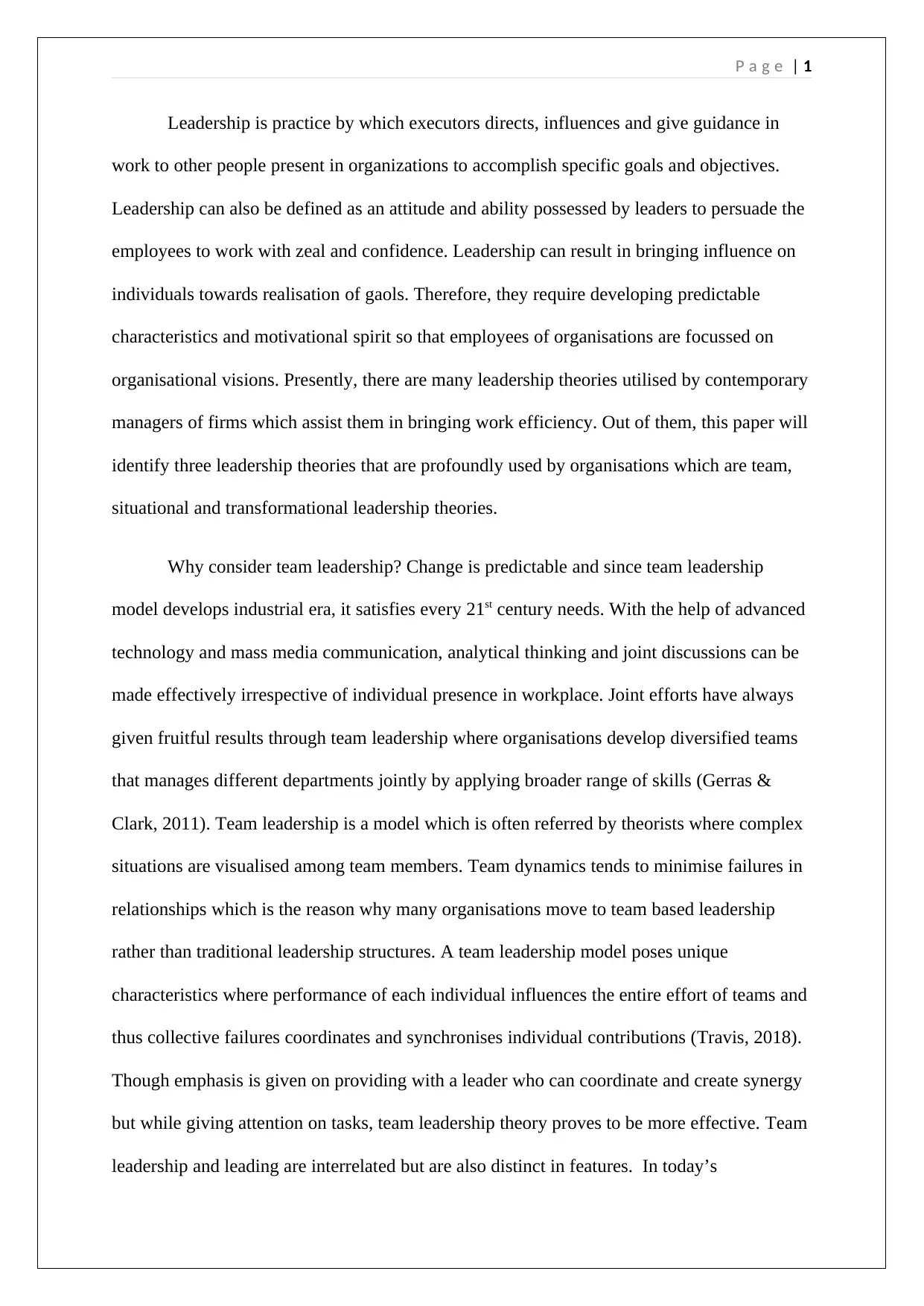
P a g e | 1
Leadership is practice by which executors directs, influences and give guidance in
work to other people present in organizations to accomplish specific goals and objectives.
Leadership can also be defined as an attitude and ability possessed by leaders to persuade the
employees to work with zeal and confidence. Leadership can result in bringing influence on
individuals towards realisation of gaols. Therefore, they require developing predictable
characteristics and motivational spirit so that employees of organisations are focussed on
organisational visions. Presently, there are many leadership theories utilised by contemporary
managers of firms which assist them in bringing work efficiency. Out of them, this paper will
identify three leadership theories that are profoundly used by organisations which are team,
situational and transformational leadership theories.
Why consider team leadership? Change is predictable and since team leadership
model develops industrial era, it satisfies every 21st century needs. With the help of advanced
technology and mass media communication, analytical thinking and joint discussions can be
made effectively irrespective of individual presence in workplace. Joint efforts have always
given fruitful results through team leadership where organisations develop diversified teams
that manages different departments jointly by applying broader range of skills (Gerras &
Clark, 2011). Team leadership is a model which is often referred by theorists where complex
situations are visualised among team members. Team dynamics tends to minimise failures in
relationships which is the reason why many organisations move to team based leadership
rather than traditional leadership structures. A team leadership model poses unique
characteristics where performance of each individual influences the entire effort of teams and
thus collective failures coordinates and synchronises individual contributions (Travis, 2018).
Though emphasis is given on providing with a leader who can coordinate and create synergy
but while giving attention on tasks, team leadership theory proves to be more effective. Team
leadership and leading are interrelated but are also distinct in features. In today’s
Leadership is practice by which executors directs, influences and give guidance in
work to other people present in organizations to accomplish specific goals and objectives.
Leadership can also be defined as an attitude and ability possessed by leaders to persuade the
employees to work with zeal and confidence. Leadership can result in bringing influence on
individuals towards realisation of gaols. Therefore, they require developing predictable
characteristics and motivational spirit so that employees of organisations are focussed on
organisational visions. Presently, there are many leadership theories utilised by contemporary
managers of firms which assist them in bringing work efficiency. Out of them, this paper will
identify three leadership theories that are profoundly used by organisations which are team,
situational and transformational leadership theories.
Why consider team leadership? Change is predictable and since team leadership
model develops industrial era, it satisfies every 21st century needs. With the help of advanced
technology and mass media communication, analytical thinking and joint discussions can be
made effectively irrespective of individual presence in workplace. Joint efforts have always
given fruitful results through team leadership where organisations develop diversified teams
that manages different departments jointly by applying broader range of skills (Gerras &
Clark, 2011). Team leadership is a model which is often referred by theorists where complex
situations are visualised among team members. Team dynamics tends to minimise failures in
relationships which is the reason why many organisations move to team based leadership
rather than traditional leadership structures. A team leadership model poses unique
characteristics where performance of each individual influences the entire effort of teams and
thus collective failures coordinates and synchronises individual contributions (Travis, 2018).
Though emphasis is given on providing with a leader who can coordinate and create synergy
but while giving attention on tasks, team leadership theory proves to be more effective. Team
leadership and leading are interrelated but are also distinct in features. In today’s
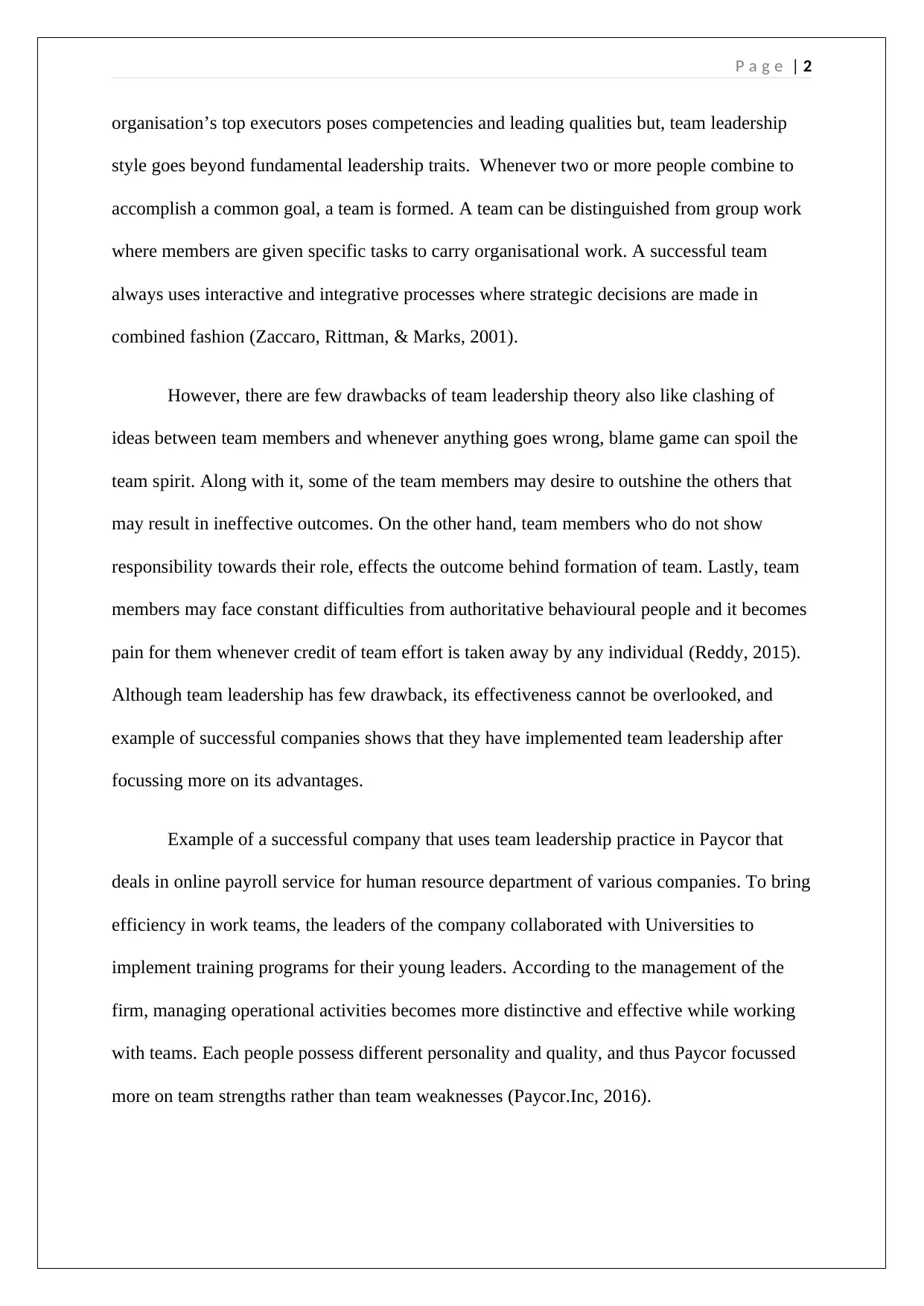
P a g e | 2
organisation’s top executors poses competencies and leading qualities but, team leadership
style goes beyond fundamental leadership traits. Whenever two or more people combine to
accomplish a common goal, a team is formed. A team can be distinguished from group work
where members are given specific tasks to carry organisational work. A successful team
always uses interactive and integrative processes where strategic decisions are made in
combined fashion (Zaccaro, Rittman, & Marks, 2001).
However, there are few drawbacks of team leadership theory also like clashing of
ideas between team members and whenever anything goes wrong, blame game can spoil the
team spirit. Along with it, some of the team members may desire to outshine the others that
may result in ineffective outcomes. On the other hand, team members who do not show
responsibility towards their role, effects the outcome behind formation of team. Lastly, team
members may face constant difficulties from authoritative behavioural people and it becomes
pain for them whenever credit of team effort is taken away by any individual (Reddy, 2015).
Although team leadership has few drawback, its effectiveness cannot be overlooked, and
example of successful companies shows that they have implemented team leadership after
focussing more on its advantages.
Example of a successful company that uses team leadership practice in Paycor that
deals in online payroll service for human resource department of various companies. To bring
efficiency in work teams, the leaders of the company collaborated with Universities to
implement training programs for their young leaders. According to the management of the
firm, managing operational activities becomes more distinctive and effective while working
with teams. Each people possess different personality and quality, and thus Paycor focussed
more on team strengths rather than team weaknesses (Paycor.Inc, 2016).
organisation’s top executors poses competencies and leading qualities but, team leadership
style goes beyond fundamental leadership traits. Whenever two or more people combine to
accomplish a common goal, a team is formed. A team can be distinguished from group work
where members are given specific tasks to carry organisational work. A successful team
always uses interactive and integrative processes where strategic decisions are made in
combined fashion (Zaccaro, Rittman, & Marks, 2001).
However, there are few drawbacks of team leadership theory also like clashing of
ideas between team members and whenever anything goes wrong, blame game can spoil the
team spirit. Along with it, some of the team members may desire to outshine the others that
may result in ineffective outcomes. On the other hand, team members who do not show
responsibility towards their role, effects the outcome behind formation of team. Lastly, team
members may face constant difficulties from authoritative behavioural people and it becomes
pain for them whenever credit of team effort is taken away by any individual (Reddy, 2015).
Although team leadership has few drawback, its effectiveness cannot be overlooked, and
example of successful companies shows that they have implemented team leadership after
focussing more on its advantages.
Example of a successful company that uses team leadership practice in Paycor that
deals in online payroll service for human resource department of various companies. To bring
efficiency in work teams, the leaders of the company collaborated with Universities to
implement training programs for their young leaders. According to the management of the
firm, managing operational activities becomes more distinctive and effective while working
with teams. Each people possess different personality and quality, and thus Paycor focussed
more on team strengths rather than team weaknesses (Paycor.Inc, 2016).
⊘ This is a preview!⊘
Do you want full access?
Subscribe today to unlock all pages.

Trusted by 1+ million students worldwide
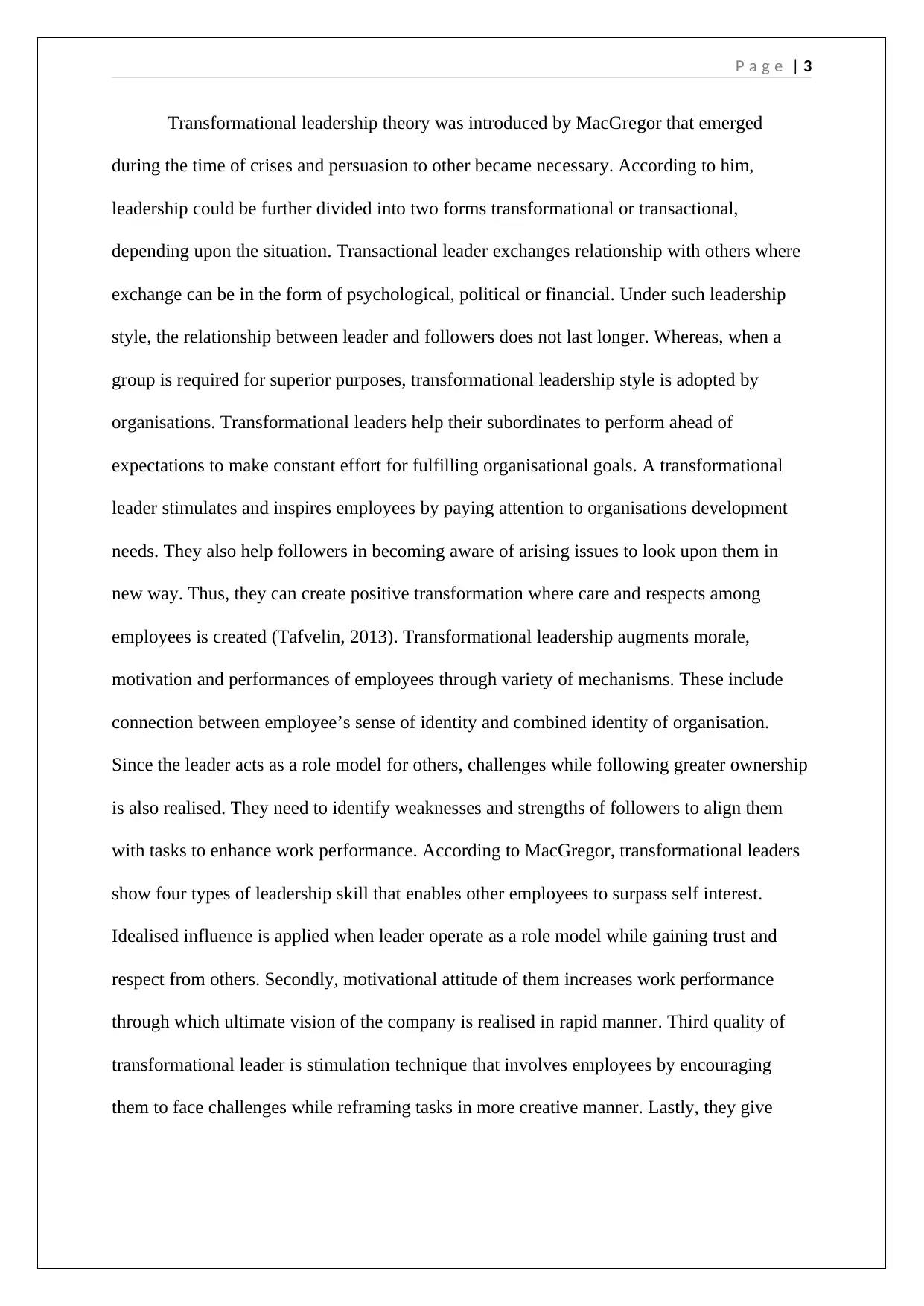
P a g e | 3
Transformational leadership theory was introduced by MacGregor that emerged
during the time of crises and persuasion to other became necessary. According to him,
leadership could be further divided into two forms transformational or transactional,
depending upon the situation. Transactional leader exchanges relationship with others where
exchange can be in the form of psychological, political or financial. Under such leadership
style, the relationship between leader and followers does not last longer. Whereas, when a
group is required for superior purposes, transformational leadership style is adopted by
organisations. Transformational leaders help their subordinates to perform ahead of
expectations to make constant effort for fulfilling organisational goals. A transformational
leader stimulates and inspires employees by paying attention to organisations development
needs. They also help followers in becoming aware of arising issues to look upon them in
new way. Thus, they can create positive transformation where care and respects among
employees is created (Tafvelin, 2013). Transformational leadership augments morale,
motivation and performances of employees through variety of mechanisms. These include
connection between employee’s sense of identity and combined identity of organisation.
Since the leader acts as a role model for others, challenges while following greater ownership
is also realised. They need to identify weaknesses and strengths of followers to align them
with tasks to enhance work performance. According to MacGregor, transformational leaders
show four types of leadership skill that enables other employees to surpass self interest.
Idealised influence is applied when leader operate as a role model while gaining trust and
respect from others. Secondly, motivational attitude of them increases work performance
through which ultimate vision of the company is realised in rapid manner. Third quality of
transformational leader is stimulation technique that involves employees by encouraging
them to face challenges while reframing tasks in more creative manner. Lastly, they give
Transformational leadership theory was introduced by MacGregor that emerged
during the time of crises and persuasion to other became necessary. According to him,
leadership could be further divided into two forms transformational or transactional,
depending upon the situation. Transactional leader exchanges relationship with others where
exchange can be in the form of psychological, political or financial. Under such leadership
style, the relationship between leader and followers does not last longer. Whereas, when a
group is required for superior purposes, transformational leadership style is adopted by
organisations. Transformational leaders help their subordinates to perform ahead of
expectations to make constant effort for fulfilling organisational goals. A transformational
leader stimulates and inspires employees by paying attention to organisations development
needs. They also help followers in becoming aware of arising issues to look upon them in
new way. Thus, they can create positive transformation where care and respects among
employees is created (Tafvelin, 2013). Transformational leadership augments morale,
motivation and performances of employees through variety of mechanisms. These include
connection between employee’s sense of identity and combined identity of organisation.
Since the leader acts as a role model for others, challenges while following greater ownership
is also realised. They need to identify weaknesses and strengths of followers to align them
with tasks to enhance work performance. According to MacGregor, transformational leaders
show four types of leadership skill that enables other employees to surpass self interest.
Idealised influence is applied when leader operate as a role model while gaining trust and
respect from others. Secondly, motivational attitude of them increases work performance
through which ultimate vision of the company is realised in rapid manner. Third quality of
transformational leader is stimulation technique that involves employees by encouraging
them to face challenges while reframing tasks in more creative manner. Lastly, they give
Paraphrase This Document
Need a fresh take? Get an instant paraphrase of this document with our AI Paraphraser
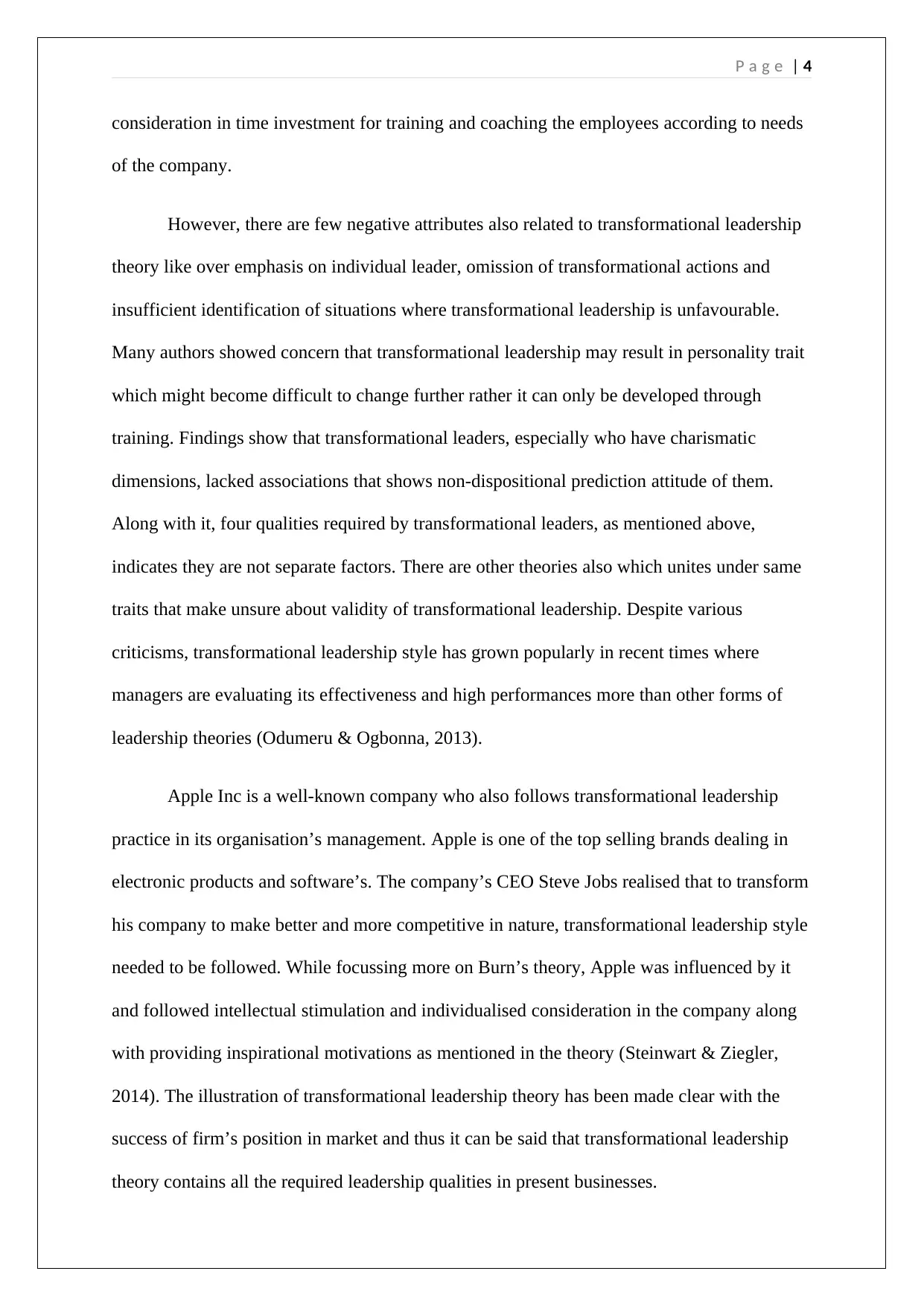
P a g e | 4
consideration in time investment for training and coaching the employees according to needs
of the company.
However, there are few negative attributes also related to transformational leadership
theory like over emphasis on individual leader, omission of transformational actions and
insufficient identification of situations where transformational leadership is unfavourable.
Many authors showed concern that transformational leadership may result in personality trait
which might become difficult to change further rather it can only be developed through
training. Findings show that transformational leaders, especially who have charismatic
dimensions, lacked associations that shows non-dispositional prediction attitude of them.
Along with it, four qualities required by transformational leaders, as mentioned above,
indicates they are not separate factors. There are other theories also which unites under same
traits that make unsure about validity of transformational leadership. Despite various
criticisms, transformational leadership style has grown popularly in recent times where
managers are evaluating its effectiveness and high performances more than other forms of
leadership theories (Odumeru & Ogbonna, 2013).
Apple Inc is a well-known company who also follows transformational leadership
practice in its organisation’s management. Apple is one of the top selling brands dealing in
electronic products and software’s. The company’s CEO Steve Jobs realised that to transform
his company to make better and more competitive in nature, transformational leadership style
needed to be followed. While focussing more on Burn’s theory, Apple was influenced by it
and followed intellectual stimulation and individualised consideration in the company along
with providing inspirational motivations as mentioned in the theory (Steinwart & Ziegler,
2014). The illustration of transformational leadership theory has been made clear with the
success of firm’s position in market and thus it can be said that transformational leadership
theory contains all the required leadership qualities in present businesses.
consideration in time investment for training and coaching the employees according to needs
of the company.
However, there are few negative attributes also related to transformational leadership
theory like over emphasis on individual leader, omission of transformational actions and
insufficient identification of situations where transformational leadership is unfavourable.
Many authors showed concern that transformational leadership may result in personality trait
which might become difficult to change further rather it can only be developed through
training. Findings show that transformational leaders, especially who have charismatic
dimensions, lacked associations that shows non-dispositional prediction attitude of them.
Along with it, four qualities required by transformational leaders, as mentioned above,
indicates they are not separate factors. There are other theories also which unites under same
traits that make unsure about validity of transformational leadership. Despite various
criticisms, transformational leadership style has grown popularly in recent times where
managers are evaluating its effectiveness and high performances more than other forms of
leadership theories (Odumeru & Ogbonna, 2013).
Apple Inc is a well-known company who also follows transformational leadership
practice in its organisation’s management. Apple is one of the top selling brands dealing in
electronic products and software’s. The company’s CEO Steve Jobs realised that to transform
his company to make better and more competitive in nature, transformational leadership style
needed to be followed. While focussing more on Burn’s theory, Apple was influenced by it
and followed intellectual stimulation and individualised consideration in the company along
with providing inspirational motivations as mentioned in the theory (Steinwart & Ziegler,
2014). The illustration of transformational leadership theory has been made clear with the
success of firm’s position in market and thus it can be said that transformational leadership
theory contains all the required leadership qualities in present businesses.
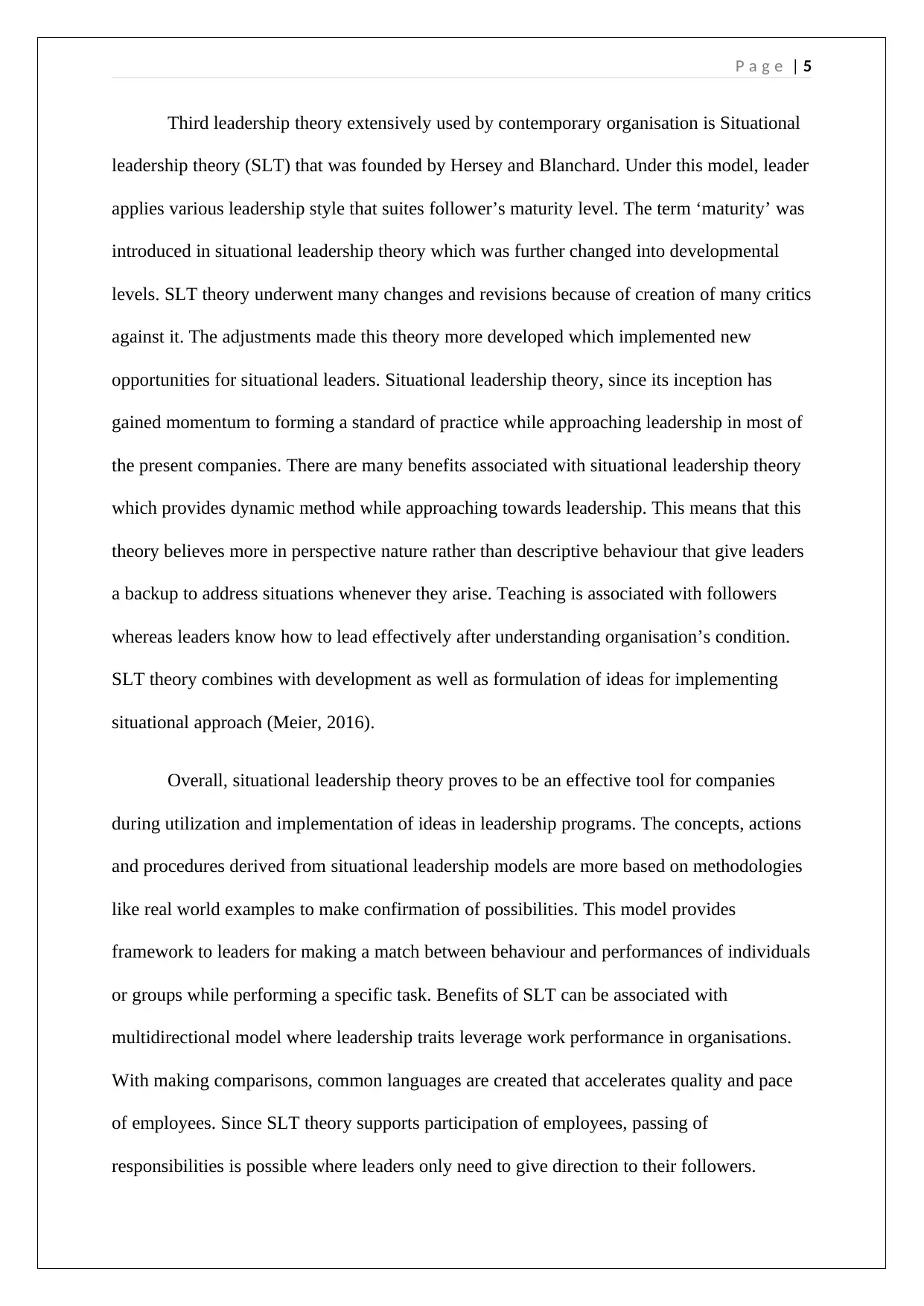
P a g e | 5
Third leadership theory extensively used by contemporary organisation is Situational
leadership theory (SLT) that was founded by Hersey and Blanchard. Under this model, leader
applies various leadership style that suites follower’s maturity level. The term ‘maturity’ was
introduced in situational leadership theory which was further changed into developmental
levels. SLT theory underwent many changes and revisions because of creation of many critics
against it. The adjustments made this theory more developed which implemented new
opportunities for situational leaders. Situational leadership theory, since its inception has
gained momentum to forming a standard of practice while approaching leadership in most of
the present companies. There are many benefits associated with situational leadership theory
which provides dynamic method while approaching towards leadership. This means that this
theory believes more in perspective nature rather than descriptive behaviour that give leaders
a backup to address situations whenever they arise. Teaching is associated with followers
whereas leaders know how to lead effectively after understanding organisation’s condition.
SLT theory combines with development as well as formulation of ideas for implementing
situational approach (Meier, 2016).
Overall, situational leadership theory proves to be an effective tool for companies
during utilization and implementation of ideas in leadership programs. The concepts, actions
and procedures derived from situational leadership models are more based on methodologies
like real world examples to make confirmation of possibilities. This model provides
framework to leaders for making a match between behaviour and performances of individuals
or groups while performing a specific task. Benefits of SLT can be associated with
multidirectional model where leadership traits leverage work performance in organisations.
With making comparisons, common languages are created that accelerates quality and pace
of employees. Since SLT theory supports participation of employees, passing of
responsibilities is possible where leaders only need to give direction to their followers.
Third leadership theory extensively used by contemporary organisation is Situational
leadership theory (SLT) that was founded by Hersey and Blanchard. Under this model, leader
applies various leadership style that suites follower’s maturity level. The term ‘maturity’ was
introduced in situational leadership theory which was further changed into developmental
levels. SLT theory underwent many changes and revisions because of creation of many critics
against it. The adjustments made this theory more developed which implemented new
opportunities for situational leaders. Situational leadership theory, since its inception has
gained momentum to forming a standard of practice while approaching leadership in most of
the present companies. There are many benefits associated with situational leadership theory
which provides dynamic method while approaching towards leadership. This means that this
theory believes more in perspective nature rather than descriptive behaviour that give leaders
a backup to address situations whenever they arise. Teaching is associated with followers
whereas leaders know how to lead effectively after understanding organisation’s condition.
SLT theory combines with development as well as formulation of ideas for implementing
situational approach (Meier, 2016).
Overall, situational leadership theory proves to be an effective tool for companies
during utilization and implementation of ideas in leadership programs. The concepts, actions
and procedures derived from situational leadership models are more based on methodologies
like real world examples to make confirmation of possibilities. This model provides
framework to leaders for making a match between behaviour and performances of individuals
or groups while performing a specific task. Benefits of SLT can be associated with
multidirectional model where leadership traits leverage work performance in organisations.
With making comparisons, common languages are created that accelerates quality and pace
of employees. Since SLT theory supports participation of employees, passing of
responsibilities is possible where leaders only need to give direction to their followers.
⊘ This is a preview!⊘
Do you want full access?
Subscribe today to unlock all pages.

Trusted by 1+ million students worldwide
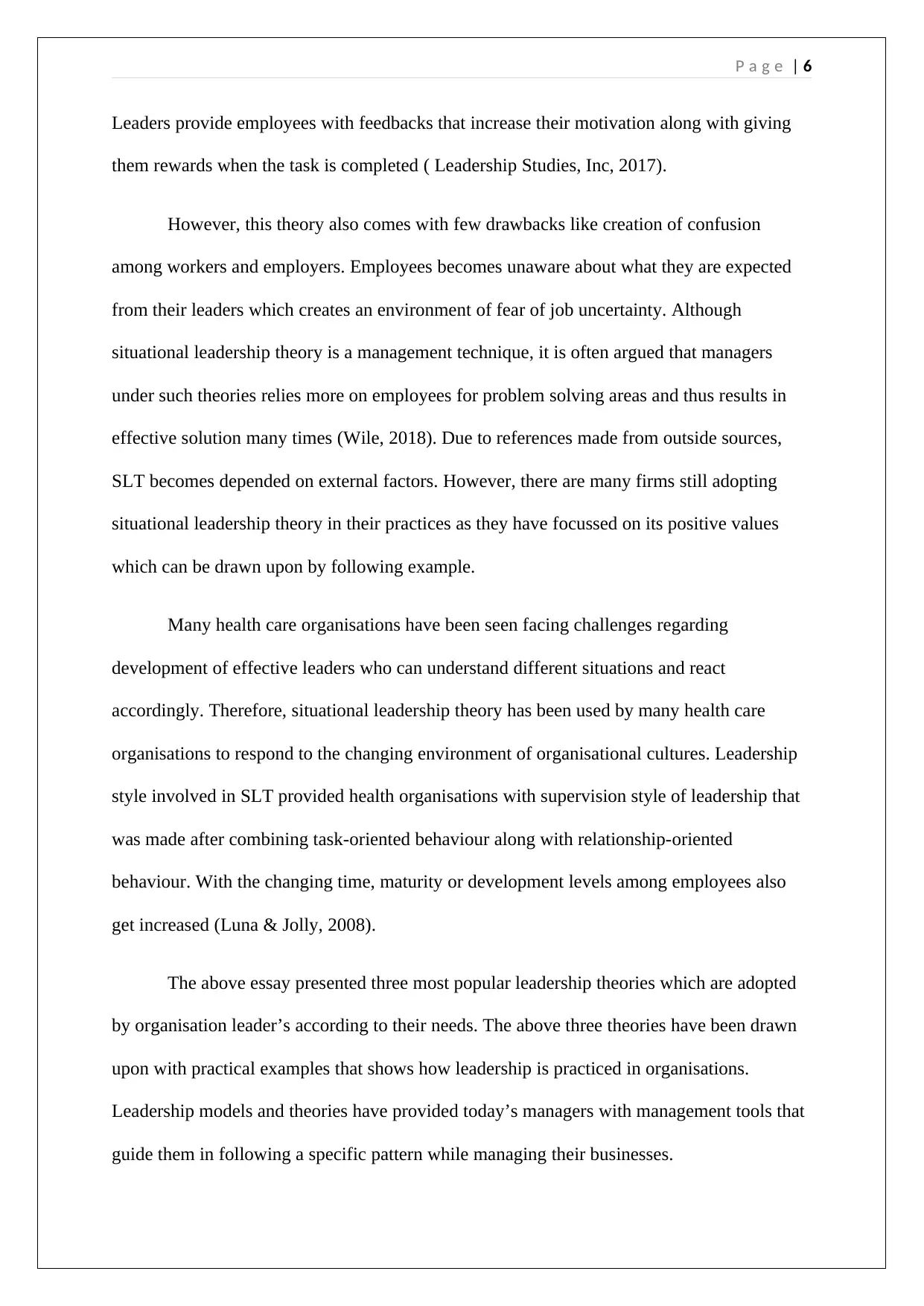
P a g e | 6
Leaders provide employees with feedbacks that increase their motivation along with giving
them rewards when the task is completed ( Leadership Studies, Inc, 2017).
However, this theory also comes with few drawbacks like creation of confusion
among workers and employers. Employees becomes unaware about what they are expected
from their leaders which creates an environment of fear of job uncertainty. Although
situational leadership theory is a management technique, it is often argued that managers
under such theories relies more on employees for problem solving areas and thus results in
effective solution many times (Wile, 2018). Due to references made from outside sources,
SLT becomes depended on external factors. However, there are many firms still adopting
situational leadership theory in their practices as they have focussed on its positive values
which can be drawn upon by following example.
Many health care organisations have been seen facing challenges regarding
development of effective leaders who can understand different situations and react
accordingly. Therefore, situational leadership theory has been used by many health care
organisations to respond to the changing environment of organisational cultures. Leadership
style involved in SLT provided health organisations with supervision style of leadership that
was made after combining task-oriented behaviour along with relationship-oriented
behaviour. With the changing time, maturity or development levels among employees also
get increased (Luna & Jolly, 2008).
The above essay presented three most popular leadership theories which are adopted
by organisation leader’s according to their needs. The above three theories have been drawn
upon with practical examples that shows how leadership is practiced in organisations.
Leadership models and theories have provided today’s managers with management tools that
guide them in following a specific pattern while managing their businesses.
Leaders provide employees with feedbacks that increase their motivation along with giving
them rewards when the task is completed ( Leadership Studies, Inc, 2017).
However, this theory also comes with few drawbacks like creation of confusion
among workers and employers. Employees becomes unaware about what they are expected
from their leaders which creates an environment of fear of job uncertainty. Although
situational leadership theory is a management technique, it is often argued that managers
under such theories relies more on employees for problem solving areas and thus results in
effective solution many times (Wile, 2018). Due to references made from outside sources,
SLT becomes depended on external factors. However, there are many firms still adopting
situational leadership theory in their practices as they have focussed on its positive values
which can be drawn upon by following example.
Many health care organisations have been seen facing challenges regarding
development of effective leaders who can understand different situations and react
accordingly. Therefore, situational leadership theory has been used by many health care
organisations to respond to the changing environment of organisational cultures. Leadership
style involved in SLT provided health organisations with supervision style of leadership that
was made after combining task-oriented behaviour along with relationship-oriented
behaviour. With the changing time, maturity or development levels among employees also
get increased (Luna & Jolly, 2008).
The above essay presented three most popular leadership theories which are adopted
by organisation leader’s according to their needs. The above three theories have been drawn
upon with practical examples that shows how leadership is practiced in organisations.
Leadership models and theories have provided today’s managers with management tools that
guide them in following a specific pattern while managing their businesses.
Paraphrase This Document
Need a fresh take? Get an instant paraphrase of this document with our AI Paraphraser
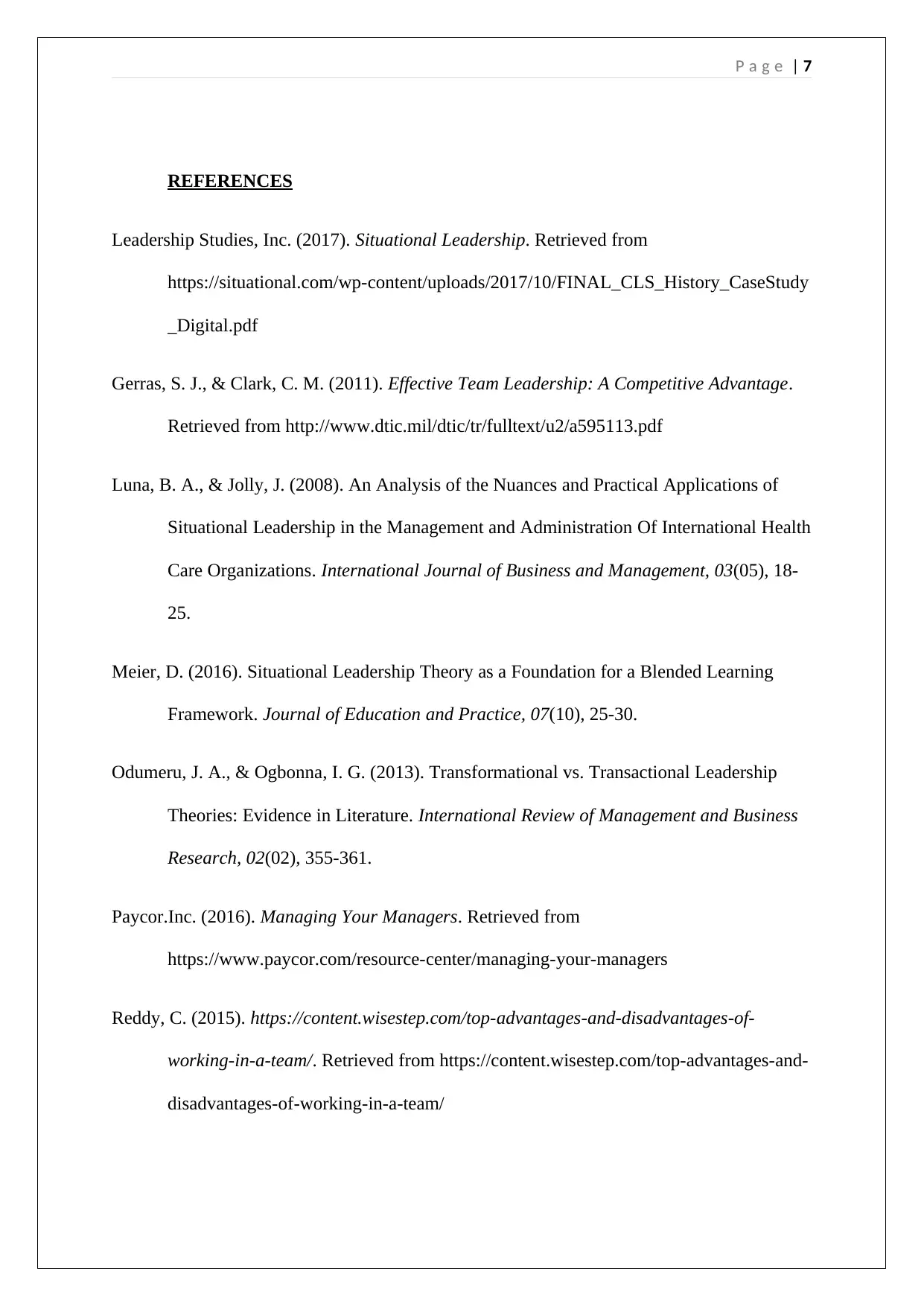
P a g e | 7
REFERENCES
Leadership Studies, Inc. (2017). Situational Leadership. Retrieved from
https://situational.com/wp-content/uploads/2017/10/FINAL_CLS_History_CaseStudy
_Digital.pdf
Gerras, S. J., & Clark, C. M. (2011). Effective Team Leadership: A Competitive Advantage.
Retrieved from http://www.dtic.mil/dtic/tr/fulltext/u2/a595113.pdf
Luna, B. A., & Jolly, J. (2008). An Analysis of the Nuances and Practical Applications of
Situational Leadership in the Management and Administration Of International Health
Care Organizations. International Journal of Business and Management, 03(05), 18-
25.
Meier, D. (2016). Situational Leadership Theory as a Foundation for a Blended Learning
Framework. Journal of Education and Practice, 07(10), 25-30.
Odumeru, J. A., & Ogbonna, I. G. (2013). Transformational vs. Transactional Leadership
Theories: Evidence in Literature. International Review of Management and Business
Research, 02(02), 355-361.
Paycor.Inc. (2016). Managing Your Managers. Retrieved from
https://www.paycor.com/resource-center/managing-your-managers
Reddy, C. (2015). https://content.wisestep.com/top-advantages-and-disadvantages-of-
working-in-a-team/. Retrieved from https://content.wisestep.com/top-advantages-and-
disadvantages-of-working-in-a-team/
REFERENCES
Leadership Studies, Inc. (2017). Situational Leadership. Retrieved from
https://situational.com/wp-content/uploads/2017/10/FINAL_CLS_History_CaseStudy
_Digital.pdf
Gerras, S. J., & Clark, C. M. (2011). Effective Team Leadership: A Competitive Advantage.
Retrieved from http://www.dtic.mil/dtic/tr/fulltext/u2/a595113.pdf
Luna, B. A., & Jolly, J. (2008). An Analysis of the Nuances and Practical Applications of
Situational Leadership in the Management and Administration Of International Health
Care Organizations. International Journal of Business and Management, 03(05), 18-
25.
Meier, D. (2016). Situational Leadership Theory as a Foundation for a Blended Learning
Framework. Journal of Education and Practice, 07(10), 25-30.
Odumeru, J. A., & Ogbonna, I. G. (2013). Transformational vs. Transactional Leadership
Theories: Evidence in Literature. International Review of Management and Business
Research, 02(02), 355-361.
Paycor.Inc. (2016). Managing Your Managers. Retrieved from
https://www.paycor.com/resource-center/managing-your-managers
Reddy, C. (2015). https://content.wisestep.com/top-advantages-and-disadvantages-of-
working-in-a-team/. Retrieved from https://content.wisestep.com/top-advantages-and-
disadvantages-of-working-in-a-team/
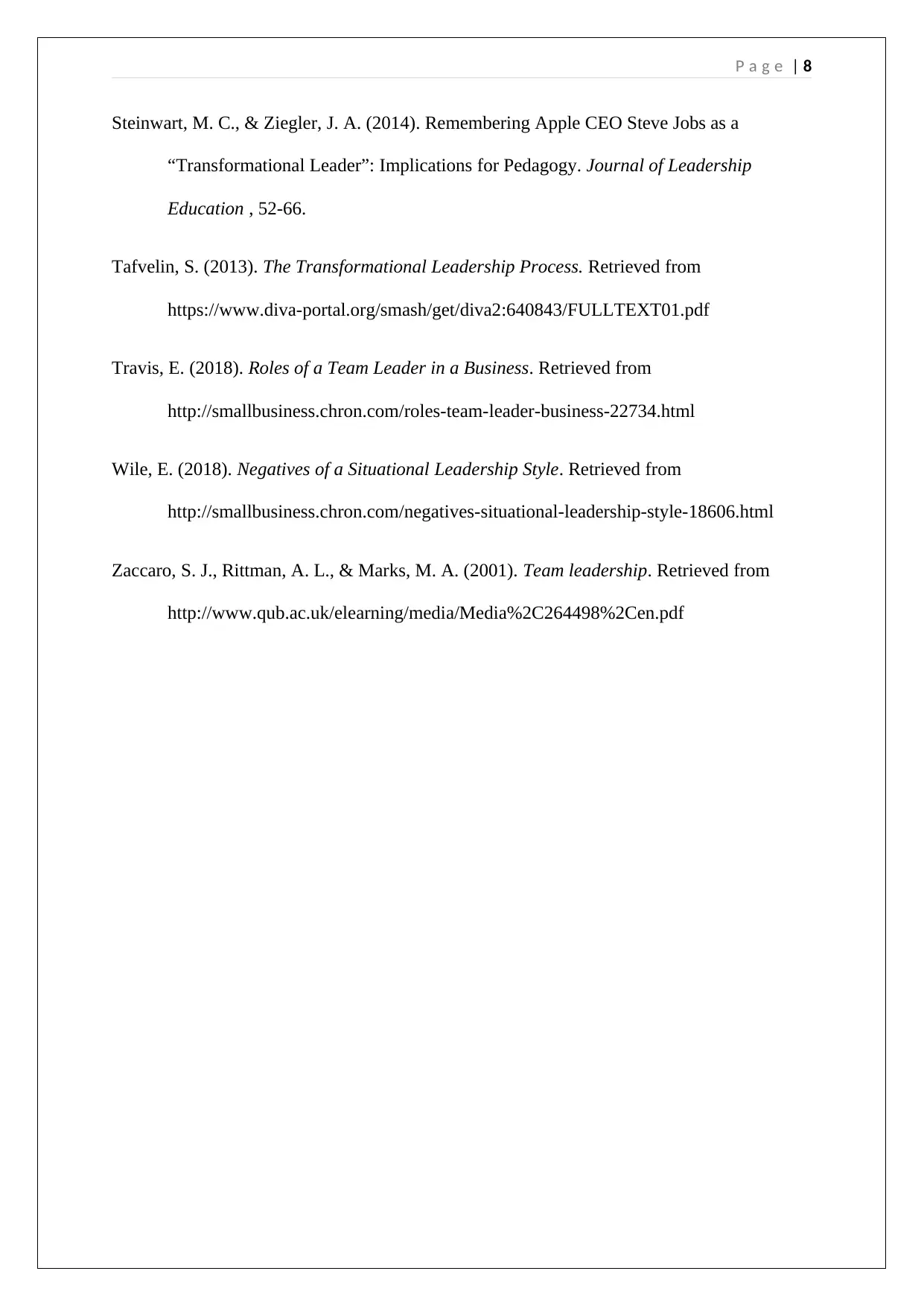
P a g e | 8
Steinwart, M. C., & Ziegler, J. A. (2014). Remembering Apple CEO Steve Jobs as a
“Transformational Leader”: Implications for Pedagogy. Journal of Leadership
Education , 52-66.
Tafvelin, S. (2013). The Transformational Leadership Process. Retrieved from
https://www.diva-portal.org/smash/get/diva2:640843/FULLTEXT01.pdf
Travis, E. (2018). Roles of a Team Leader in a Business. Retrieved from
http://smallbusiness.chron.com/roles-team-leader-business-22734.html
Wile, E. (2018). Negatives of a Situational Leadership Style. Retrieved from
http://smallbusiness.chron.com/negatives-situational-leadership-style-18606.html
Zaccaro, S. J., Rittman, A. L., & Marks, M. A. (2001). Team leadership. Retrieved from
http://www.qub.ac.uk/elearning/media/Media%2C264498%2Cen.pdf
Steinwart, M. C., & Ziegler, J. A. (2014). Remembering Apple CEO Steve Jobs as a
“Transformational Leader”: Implications for Pedagogy. Journal of Leadership
Education , 52-66.
Tafvelin, S. (2013). The Transformational Leadership Process. Retrieved from
https://www.diva-portal.org/smash/get/diva2:640843/FULLTEXT01.pdf
Travis, E. (2018). Roles of a Team Leader in a Business. Retrieved from
http://smallbusiness.chron.com/roles-team-leader-business-22734.html
Wile, E. (2018). Negatives of a Situational Leadership Style. Retrieved from
http://smallbusiness.chron.com/negatives-situational-leadership-style-18606.html
Zaccaro, S. J., Rittman, A. L., & Marks, M. A. (2001). Team leadership. Retrieved from
http://www.qub.ac.uk/elearning/media/Media%2C264498%2Cen.pdf
⊘ This is a preview!⊘
Do you want full access?
Subscribe today to unlock all pages.

Trusted by 1+ million students worldwide
1 out of 9
Related Documents
Your All-in-One AI-Powered Toolkit for Academic Success.
+13062052269
info@desklib.com
Available 24*7 on WhatsApp / Email
![[object Object]](/_next/static/media/star-bottom.7253800d.svg)
Unlock your academic potential
Copyright © 2020–2025 A2Z Services. All Rights Reserved. Developed and managed by ZUCOL.





